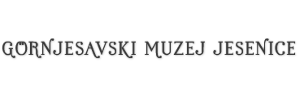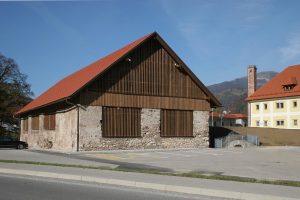Iron foundry settlement Stara Sava
Due to its exceptional urban, technical, architectural and historical significance, ironmaking settlement Stara Sava in Jesenice has been proclaimed a cultural monument of national significance.
The former settlement Sava (nowadays Stara Sava) in Jesenice has been preserved with the central buildings with most characteristics of an ironmaking settlement at the end of the 17th century, as depicted on a copper plate engraving by Andrej Trosta in Valvasor’s The Glory of the Duchy of Carniola. The focal point of the ironmaking settlement Stara Sava is the central square, surrounded by the preserved and presented ironmaking industrial facilities, particularly the remains of the blast furnace – a facility for melting iron ore with wood coal, built in the beginning of the 16th century and later renovated and supplemented for several times. To the east, there is the workers’ Kasarna, a late-baroque building from the end of the 18th century, and one of the oldest preserved examples of common workers’ flats in our country. Ironmaking Bucelleni-Ruard Manor from the beginning of the 16th century and ironmaking Church of St. Mary’s Assumption from the beginning of the 17th century dominate in the north of the square. Kolpern – one of the former four buildings where coal used to be stored, has been preserved in the south. Today the area serves for museum, culture and tourist activities.
Bucelleni-Ruard Manor
Bucelleni-Ruard ironmaking Manor was built by the Bucellenis around 1538. Its baroque elements were added during the renovations in 1766 and in mid-19th century. With its central hall, various quality construction and art elements have been preserved, such as stone frames, portals and documented paintings with Renaissance, historical and Secession motifs.
• Slovenski železarski muzej – Slovenian Ironmaking museum
• For renting (celebrations, weddings …)
Ironmaking Church of St. Mary’s Assumption
It is one of the first examples of Jesuit architecture in Slovenia, dating back to 1606. It is built of three-nave arched hall with matrones above the side naves. baroque elements were added later. A big Baroque marble altar has been preserved very well (dating back to the first decade of the 18th century), whose style classification is associated with early-Baroque Italian type of marble altars and can be regarded as belonging to the Mihael Kuša (Cussa)’s stonemason workshop from Ljubljana. The Baroque altar was decorated by Venetian rococo painter Nicola Grassi (1682–1748). The church was decorated also by paintings by Ljubljana baroque painters Andrej Herrlein (1738–1817) and Janez Potočnik (1749–1834) and some other late-Baroque painting masters of Layer’s circle.
Museum of Workers’ Culture Jesenice
Kasarna is a late Baroque building dating from the end of the 18th century. It is one of the oldest preserved examples of common workers’ flats in our country. Ironmaking families lived there until 1983. In 1985 it was listed as a cultural monument, and in 1985 it was renovated by the Municipality of Jesenice under the authority of the Institute for the Protection of Cultural Heritage Kranj. Nowadays it houses Music School Jesenice and Gornjesavski muzej Jesenice. Visitors can see a permanent ethnological exhibition which shows the lifestyle of ironmaking families and a reconstruction of a worker’s flat. Archive and photographic material of the Carniolan Industrial Company and photographs of the Ironworks of Jesenice are kept in Kasarna.
Kolpern
This was a covered and airy storage for charcoal in foundry settlement Stara Sava. It is shown in the land registry map (1868) that in 1808 the original small building was extended to three connected storages. The buildings were right next to the blast furnace, supplying it with the charcoal as fuel. At the end of the 19th century the blast furnace was abandoned and the purpose of the storage was changed. Nowadays, Kolpern is the place for various cultural events, meetings, conferences and symposia, public events and also for civil wedding ceremonies, personal celebrations and wedding parties.




